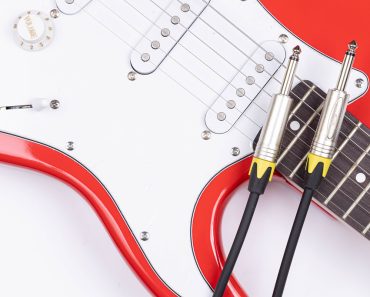Before you buy a used electric guitar, let’s go through some key things to look for. These are problems that many people overlook when they’re entranced by a lovely paint job or interesting pattern.
Fit and Finish
The first thing that most players notice on an electric guitar is the finish. Standard finish checking doesn’t detract from a used instrument’s value, but stains and discolourations do, so it’s essential to check the paint or lacquer, which may be damaged by synthetic guitar straps or chemicals. Unfortunately, if defects have penetrated the finish, you can’t simply polish them away.
Refinishing a guitar is both expensive and detrimental to its value. The majority of electric guitars are actually worth more “as is” than “refinished and beautiful.” A “refin” guitar is only valued at about half of the price of an original finish-equipped one, even if the original finish is scarred or faded.
Look for any cracks that run through the finish right down to the wood, as well as any cracks that go all the way through. A deep crack in the finish might be a symptom of separating seams in the body, whether it’s a solid, semi-hollow, or hollow instrument. Such structural damage is extremely costly to repair.

Heads Up
Heads up. Always be on the lookout for chipped or missing headstocks! The neck transition zone is prone to damage, and if the guitar is dropped or receives a blow in this area, things might go horribly wrong. Frowns and ridges on and around the headstock are signs of a headstock repair; they may indicate that the headstock has been repaired even when it has not been. When buying a used electric guitar, this can be a significant difference.
Fretboard Issues
Examine the frets closely. String wear may cause dents or divots, which can be costly to repair or replace. The cost of a fret level is generally between $150 and $300, depending on the condition of the fingerboard.
If the neck appears identical from one fret to the next, and if the truss rod permits for adjustment, that’s a good sign. However, if you look down the neck and notice a rollercoaster track, it’ll need serious work to adjust. Excessively forward or backward bowed neck indicates that the truss rod is out of adjustment, but it may also indicate that the truss rod has been stripped or fractured. Replacing a damaged truss rod is an extensive procedure.
Another major problem is the presence of a kick-up or “ramp” at the end of the neck—the last five to eight frets. This indicates that the fretboard has been bent, and depending on how severe the bend is, it might be necessary to perform a complete or partial refret.

Neck Angle
How the neck is joined to the body influences a guitar’s playability, and it’s one of the most disregarded concerns when purchasing a used instrument. Here’s what you should look for: If the bridge saddles are as low as they can go while yet maintaining an excessive action, the neck angle is excessively deep. Conversely, if the saddles are raised as far as they will go while maintaining an insufficient action, the neck angle is too shallow.
Regardless of the method, the neck angle on the guitar will need to be reset. It’s not a major repair for an electric guitar with a bolt-on neck, which costs only a little more than a standard setup. However, if the instrument has a set neck (i.e., the neck is glued into the body), changing the neck angle is very costly. Unless the guitar is worth a lot of money, it isn’t cost-effective to reset its neck in this situation.
Hardware
Inspecting the hardware is simple if you know what to look for. You can tell if the plating is in good working order at first glance. It’s a good idea to inspect the condition of the bridge adjustment screws, any neck mounting hardware, tuning key screw holes, and so on beyond that. Look for stripped threads, rounded nuts, and missing screws in the old unit.
Is there any rust? I had an ancient electric guitar in the shop recently with numerous rusted screws in the bridge. They were completely frozen up and required a lot of heat to remove. (Wipe off the hardware with a soft cloth after each playing session and use Q-tips to clean out sweat and dust in hard-to-reach places to keep this from happening to your instrument.)
If the guitar has a Tune-o-Matic-style bridge, inspect for “smiling bridge syndrome.” This occurs when the bridge frame sags or collapses between the bridge posts. If the 3rd and 4th strings are lower than the 1st and 6th, the bridge will need to be changed.
Electronics
With the instrument connected, turn the volume and tone knobs while listening for scratchy pots. Then check out the switches and gently tug on the cable at the output jack. If there’s a lot of noise or delay in the signal coming out of the guitar, further testing and repair may be required. In some situations, spraying a noisy pot or switch with contact cleaner followed by compressed air might help to eliminate noises caused by corrosion. Pots, switches, and jacks are relatively inexpensive; nevertheless, labour costs can pile up quickly.
